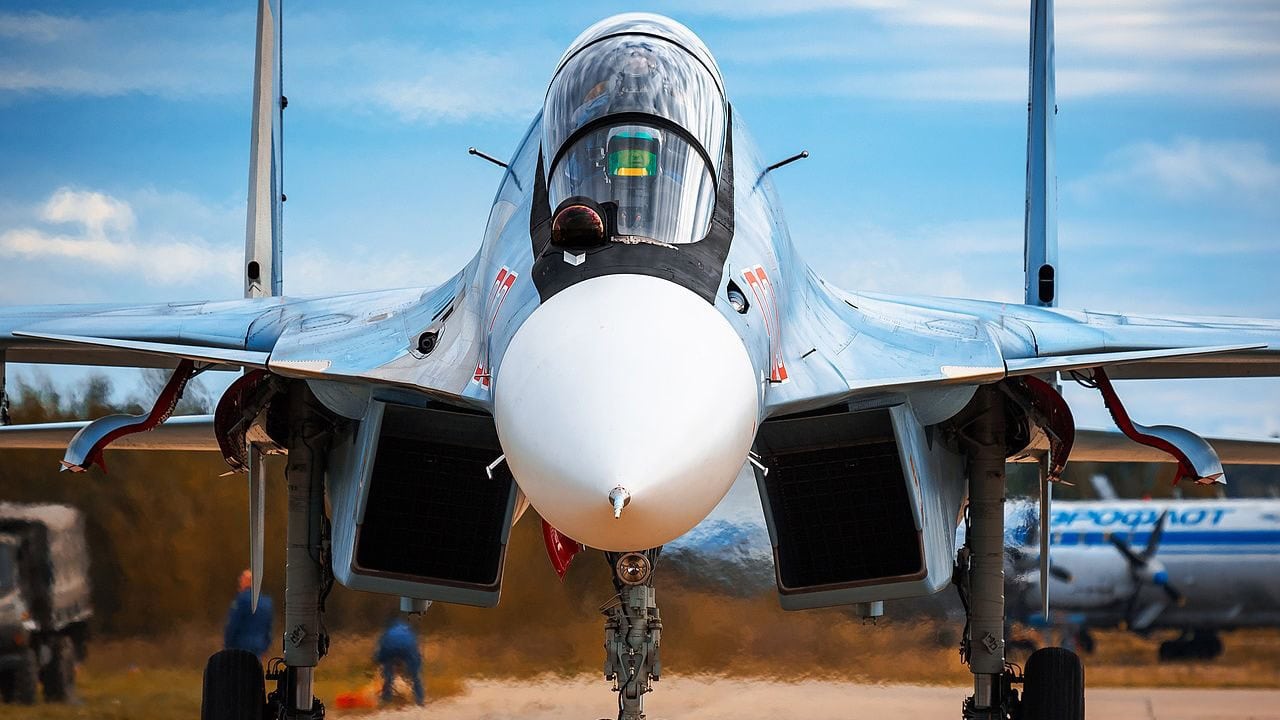The Su-30 Is No Joke: The Russian Sukoi Su-35 fighter jet emerged in the mid-1990s and has since expanded into a massive global platform operating with more than 12 countries to include China, India, Algeria, Indonesia, Malaysia, and many others. Iran is also a likely buyer for the Su-35.
But another Russian aircraft these days, the Su-30, seems to get overlooked. Here is out take on what you need to know about this important Russian weapon of war in the sky.
Russian Aircraft: Meet the Su-30
The aircraft is described by KNAANO as being composed of two key mission areas, including its air-to-air control weapons system and air-to-surface system. Operating at speeds of Mach 2, the Su-30 uses four multi-function control panels in the cockpit to target and destroy ground objectives and also launch Kh-31A anti-ship missiles from the air. This certainly indicates the aircraft operates with a significant flexibility and effectiveness when it comes to lethality. A write up from the United Aircraft Corporation describes the Su-30 as a two-seat cockpit with an airbrake behind the canopy.
Su-30 in Ukraine
As a derivative of the Su-27, the Su-30 has functioned for years as a workhorse fighter jet “bomb truck” which served in combat in Syria in 2015. More recently, multiple reports claim the Russian Su-30 has been very successful in Ukraine against Ukrainian fighter pilots, ground targets, and surface ships. Both Ukrainian and Russian sources report heavy aircraft losses from the adversary for understandable war-information purposes, yet the exact number is difficult to discern in a precise or reliable way.
Perhaps the best information might suggest that air combat losses are roughly equivalent between Ukraine and Russia, according to USAFE-AFAFRICA Commander Gen. James Hecker. Speaking at the Air Force Association and cited in Air and Space Magazine, Hecker said in March 2023 that Ukraine has lost 60 aircraft compared to Russia having lost 70.
Perhaps the best indicator of a potential “stalemate” or uncertainty regarding the performance of Russian aircraft lies in the surprising and even mysterious fact that neither Russia nor Ukraine has achieved air superiority in the war over Ukraine. This fact, seemingly surprising given Russia’s reported massive fighter jet fleet-size advantage, is believed to be due to Ukrainian tenacity, air defenses, “will to fight,” and possibly poor Russian morale and combat performance.
While Russia is reported to operate more than 700 fighter jets, the extent to which they are maintained, operational and able to mass in formations may remain questionable. GlobalFirepower lists Russia as operating 773 fighter aircraft as opposed to Ukraine at 69. There are numerous press reports and photos showing destroyed Russian Su-30s in Ukraine as well as instances of pilots of downed-planes being captured. This may be due to Ukrainian air defenses and what senior Pentagon officials have described as a Russian “reluctance” to take risks against areas heavily defended by Ukrainian anti-aircraft weapons.
The Su-30 is listed as being able to attack with a wide range of weapons, to include a 30mm cannon.
Several articles on the Su-30 suggest the aircraft, which emerged in 1996, was in part designed to rival the U.S. Air Force F-15, a 1980s platform which has been extensively upgraded in recent decades. The targeting and weapons technology on the Su-30 do appear to be substantial, as evidenced by the details provided in the KNAAPO report. The Su-30 reportedly has precision glide bombs, advanced air-to-air missiles, and infrared targeting.
“Optoelectronic sighting system includes optical location sighting system and helmet mounted target designator. The Su-30MK optical location sighting system represents a combination of IR-direction finder and a laser rangу finder, and it is used to detect and track air targets by its radiation in forward and back hemispheres, to range air and ground targets with the help of laser beam and to illuminate ground targets and destroy them by air-to-surface guided missiles with semi-active laser seekers,” KNAAPO says.
Despite this, the U.S. Air Force F-15 has been integrated with advanced high-speed computing and Advanced Electronically Scanned Array radar capable of detecting enemy targets with great resolution in multiple directions simultaneously. Perhaps the F-15’s target sensors and detection range can outmatch the Su-30? That may be unclear, yet given how the two planes are roughly comparable in terms of speed, weaponry, and thrust-to-weight ratio, the answer to which plane is superior may depend upon targeting range and weapons guidance accuracy.
Kris Osborn is the Military Affairs Editor of 19FortyFive and President of Warrior Maven – Center for Military Modernization. Osborn previously served at the Pentagon as a Highly Qualified Expert with the Office of the Assistant Secretary of the Army—Acquisition, Logistics & Technology. Osborn has also worked as an anchor and on-air military specialist at national TV networks. He has appeared as a guest military expert on Fox News, MSNBC, The Military Channel, and The History Channel. He also has a Masters Degree in Comparative Literature from Columbia University.

